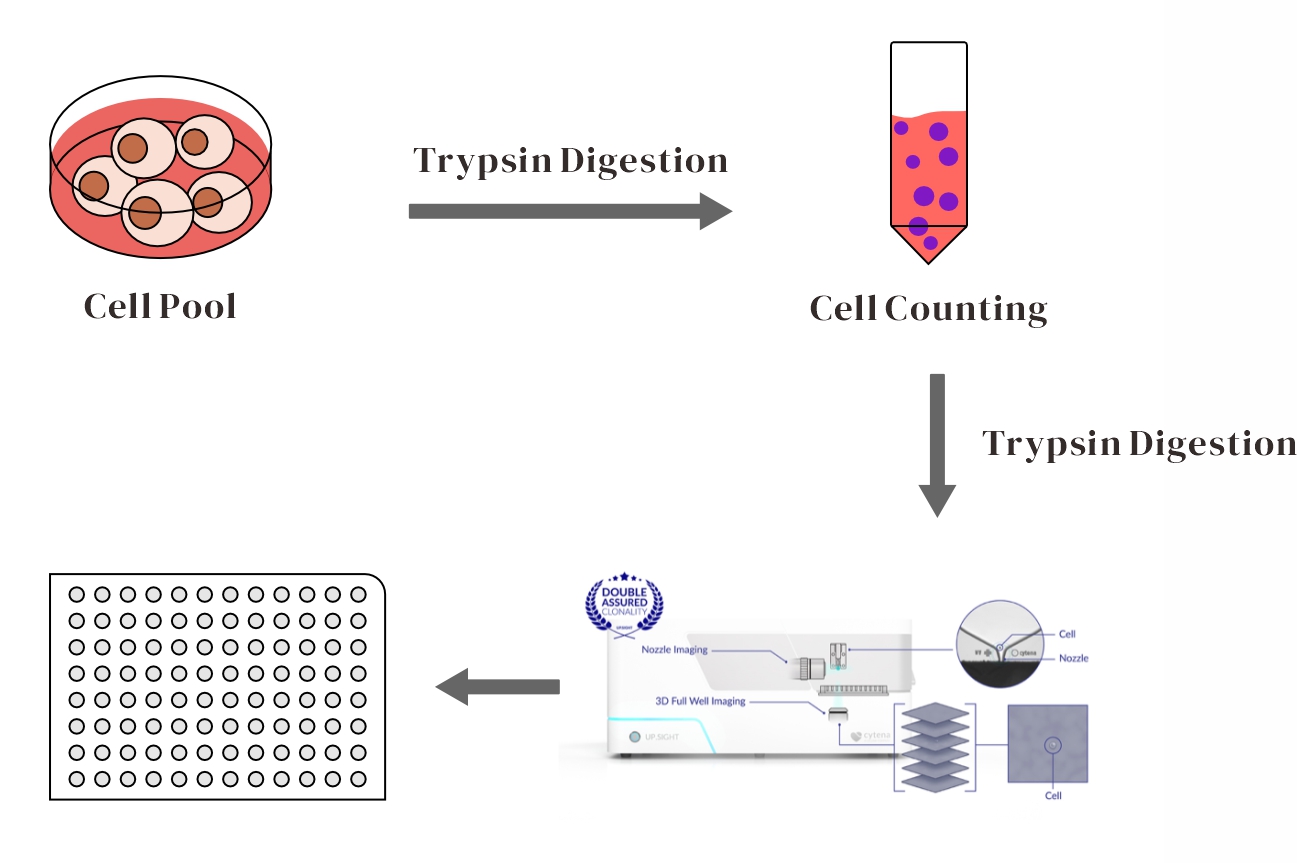 Monoclonal Screening
Monoclonal Screening
Monoclonal screening refers to isolating a single clone from a mixed cell pool, ensuring the uniformity and stability of the genetic background in cell lines. This process has significant applications in various aspects of biopharmaceutical production and research. For instance, it ensures that engineered cells used in production are derived from the same original cell, thus maintaining consistent product quality and expression levels. After gene editing or modification, cell populations typically exhibit varying degrees of genetic modification. Monoclonal screening allows for the selection of cell populations with a uniform genetic background and stable gene edits, ensuring genetic consistency across all cells.
Service Details
| Delivery Standards | At least 1 target monoclonal cell line (1×10^6 cells per line) |
|---|---|
| Timeline/Pricing |
|
EDITGENE utilizes state-of-the-art 3D single-cell printing technology to precisely isolate individual cells, significantly improving the accuracy of monoclonal screening and cell viability. This non-contact operation avoids mechanical damage and contamination, helping to preserve cell integrity and biological activity. Compared to traditional limiting dilution methods, 3D single-cell printing minimizes human error in monoclonal isolation, ensuring the reliability of screening results.

Service Advantages
Wide Applicability
Suitable for a wide range of cell types without requiring resistance or fluorescent tags.
High Screening Efficiency
100% monoclonal rate.
Reliable Screening Results
Provides clone formation images for each monoclonal selection.
Extremely High Cell Survival Rate
Gentle microfluidic technology ensures higher survival rates.
Service Process
Advantage and Characteristic

Optimazied Strategy
We have create a unique sgRNA Design Logic

Optimazied Strategy
We have create a unique sgRNA Design Logic

Optimazied Strategy
We have create a unique sgRNA Design Logic

Optimazied Strategy
We have create a unique sgRNA Design Logic
Genetic Reference Book
Integrating Gene Editing with Microfluidic Technology Brings New Breakthroughs in Monoclonal Screening 
Article Title: Droplets for Gene Editing Using CRISPR-Cas9 and Clonal Selection Improvement Using Hydrogels
This study presents an innovative approach that combines CRISPR-Cas9 gene editing technology with single-cell isolation techniques applied to induced pluripotent stem cell (hiPSC) lines. By utilizing droplets and hydrogels, this method optimizes clonal selection, significantly enhancing the efficiency of monoclonal screening while reducing the time and cost associated with generating stable cell lines. This method not only accelerates the generation of stable cell lines but also demonstrates enormous potential in disease modeling and cell physiology research, providing a more efficient and economical solution for monoclonal screening.
FAQ
How does EDITGENE ensure the purity and stability of cells during monoclonal screening?
EDITGENE’s 3D single-cell printing technology employs non-contact operation, avoiding mechanical damage and background contamination, which helps maintain cell integrity and biological activity. This technology also minimizes human error in the traditional limited dilution method of monoclonal selection, ensuring the reliability of screening results.
What unique advantages does EDITGENE offer for monoclonal screening services?
EDITGENE utilizes industry-leading 3D single-cell printing technology, which enables precise isolation and positioning of individual cells, significantly increasing the success rate and efficiency of monoclonal screening. This technology is widely applied in biomedicine research, antibody development, drug screening, and therapeutic selection, showcasing broad application prospects in cell research.
What is monoclonal screening, and why is it so important in gene editing research?
Monoclonal screening is the process of isolating a single clone from a mixed pool of cells and expanding that clone into a cell line. Monoclonal screening ensures that the cell lines used originate from a single cell, guaranteeing a high degree of genetic background consistency. After cells are gene-edited or genetically modified, the genetic background differences among the cells in the initial cell pool can be significant, making subsequent experimental results inaccurate. By using monoclonal screening, researchers can obtain cell populations with consistent genetic backgrounds and stable gene edits, allowing for stable and accurate monitoring of phenotypic changes.


 Login
Login



